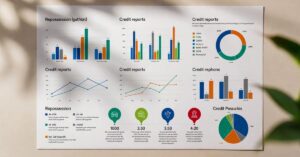Finding out that you have an overdrawn bank account is never a pleasant experience. Not only can it be embarrassing, but it can also result in costly fees. The average overdraft fee in the U.S. is around $30.
To avoid this situation, here are 10 ways to prevent overdrawing your bank account:
1. Keep track of your balance
Regularly check your account balance to know how much money you have available for spending. Use whatever system works for you, whether that’s online banking tools or simply checking your account balance before making a withdrawal or purchase.
2. Set up alerts
Many banks offer text or email alerts that will notify you when your balance is low or when a transaction exceeds a certain amount. Setting up these alerts can help you stay on top of your account and prevent overdrafts. By reviewing your account regularly via electronic alerts, you’ll also be able to quickly spot any errors or unauthorized transactions that can overdraw your account.
3. Keep tabs on your spending
Keeping an eye on your spending habits is essential to prevent overdrawing your bank account. You can use budgeting apps or tools to track your expenses and stay within your budget. Additionally, it’s important to regularly check your account balance and reconcile any discrepancies.
4. Opt-out of overdraft protection
Overdraft protection may seem like a helpful feature, but it can actually lead to more fees than you anticipate. Opting out of overdraft protection means that transactions that would overdraw your account will simply be declined, which can prevent you from incurring additional fees and charges.
5. Use cash more often
Using cash more frequently can help you avoid overspending and prevent overdrawing your bank account. When you have to give out dollar bills as payments for merchandise or services, it makes you more conscientious about your purchases and your spending decisions. You don’t have to use cash 100% of the time, but learn to operate sometimes on a cash basis (as opposed to always using credit or debit cards).
6. Set up automatic payments
Setting up automatic payments for bills and other expenses can help you avoid forgetting to make a payment and incurring fees. However, it’s important to make sure you have enough funds in your account to cover the automatic payments. You can also schedule these payments on or after paydays to ensure that you have sufficient funds in your account.
7. Avoid unnecessary fees
Banks may charge fees for a variety of services such as ATM withdrawals, overdrafts, and monthly maintenance. To prevent these fees from adding up, make sure to use ATMs within your bank’s network or switch to a bank that offers free checking accounts with no monthly maintenance fees. Additionally, keep an eye out for checking account promos, as some banks offer special deals, such as waived fees or cash bonuses, when opening a new account.
8. Keep a buffer in your account
To avoid accidentally overdrawing your account, it’s a good idea to keep a buffer of money in your account: the more dollars you can maintain (without touching!) the better. If possible, strive for a couple of hundred dollars as a buffer. If that’s not feasible, work on keeping at least a $50 to $100 buffer in your account to help cover unexpected expenses and prevent overdrafts.
9. Plan ahead for large expenses
If you know you have a big expense coming up, such as rent or a car payment — or even a one-time expenditure, say, for an airline purchase or travel — make sure to plan for it in advance. Set aside the necessary funds in your account so that you don’t accidentally overspend and end up with an overdraft fee. You can also consider setting up a separate savings account specifically for these types of expenses.
10. Eliminate those subscriptions
Many people suffer from overdrafts after a recurring charge or monthly subscription that they forgot about hits their bank account. To prevent this scenario, take a look at all your monthly subscriptions and see which ones are being automatically billed to your bank account each month. Get rid of subscriptions you no longer want, need, or use, That will reduce the risk of you sending your bank account in the red.
Following the 10 tips above will definitely help you get a handle on your banking activities and avoid unwanted overdraft fees.
Additionally, if you’re constantly struggling to prevent overdrafts, consider speaking with your bank. They may be able to offer solutions such as account restructuring or financial counseling to help you manage your finances more effectively to prevent repeated overdrawing of your account.
Don’t be afraid to ask for help if you need it!
Recognize, too, that you can choose where to bank!
Recently, many banks have improved their overdraft policies in various ways, according to research from the Pew organization. Among the improvements: banks have lowered the penalty fee for over-drafting, reduced the daily maximum number of overdraft fees charged, added a grace period or buffer amount before fees are charged, or eliminated non-sufficient funds (NSF) fees or overdraft transfer fees.
Pew researchers concluded that these changes at the largest 25 banks in America could save customers roughly $4 billion in overdraft fees.
So investigate your institution’s overdraft policies, and if you don’t like them, seek out better, more consumer-friendly options elsewhere.
Finally, if any of the terms used in this article confuse you, be sure to read on for some brief explanations.
Here is a glossary of terms used in this article:
1. Account alerts: Notifications that can be set up through text or email to notify you of low balances or transactions exceeding a certain amount.
2. Budgeting apps or tools: Digital tools that help you track your expenses and stay within your budget.
3. Overdraft protection: A feature that allows transactions to go through even if they would overdraw your account, but can lead to additional fees and debt.
4. Debit cards: A card linked to your bank account that allows you to make purchases and withdraw cash without overspending.
5. Automatic payments: Pre-scheduled payments for bills or other expenses that are deducted from your account on a regular basis.
6. ATM withdrawals: Transactions made at an ATM can incur fees if the machine is not within your bank’s network.
7. Monthly maintenance fees: A fee charged by some banks for maintaining a checking account.
8. Buffer: A few hundred dollars kept in your account to prevent accidental overdrafts.
9. Large expenses: Expenses such as rent or car payments that require planning and budgeting to avoid overspending.
10. Financial counseling: Services offered by some nonprofit agencies, community organizations, and some banks to help customers manage their finances more effectively.










